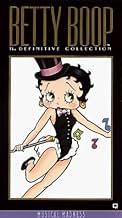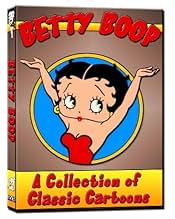CALIFICACIÓN DE IMDb
6.9/10
853
TU CALIFICACIÓN
Agrega una trama en tu idiomaIn her only color cartoon, Betty Boop goes to the ball thanks to her fairy godmother; later, only her foot fits the glass slipper.In her only color cartoon, Betty Boop goes to the ball thanks to her fairy godmother; later, only her foot fits the glass slipper.In her only color cartoon, Betty Boop goes to the ball thanks to her fairy godmother; later, only her foot fits the glass slipper.
- Dirección
- Guionista
- Elenco
Jack Mercer
- Various
- (voz)
- (sin créditos)
William Pennell
- Pumpkin
- (sin créditos)
Bonnie Poe
- Betty Boop
- (voz)
- (sin créditos)
- …
- Dirección
- Guionista
- Todo el elenco y el equipo
- Producción, taquilla y más en IMDbPro
Opiniones destacadas
10Popeye-8
Before moving on to their prolific (and highly successful) POPEYE series (as well as into their unfortunate GABBY series--just imagine Elmer Fudd without his macho sex appeal), Paramount's Fleischer brothers poured their creative genius into BETTY BOOP. This is their finest B-B cartoon, and may just be their finest EVER, period.
Using their 3-D filming process (and a unheard-of budget for a cartoon short), they adapted the Cinderella legend to Betty, adding some marvelous songs and (likely roto-scoped) beautiful dance numbers. For reasons not told, this was the only Betty Boop cartoon ever done in color--a tragedy.
Look for versions with the original opening titles intact--even the titles show that this was a project of love (and yes, money). Plus, Betty's as sexy an ingenue as ever thanks to Technicolor.
Using their 3-D filming process (and a unheard-of budget for a cartoon short), they adapted the Cinderella legend to Betty, adding some marvelous songs and (likely roto-scoped) beautiful dance numbers. For reasons not told, this was the only Betty Boop cartoon ever done in color--a tragedy.
Look for versions with the original opening titles intact--even the titles show that this was a project of love (and yes, money). Plus, Betty's as sexy an ingenue as ever thanks to Technicolor.
10llltdesq
This is an absolutely beautiful cartoon! Most Fleischer shorts were quite visually striking, to be sure, but Betty Boop only had one color cartoon-this one. While in many ways it's good that black and white was used for most of her cartoons, the sweep of this cartoon cried out for color. The Fleischers were likely also hoping that Betty's popularity would boost interest in the Color Classics series that they were starting. Betty as Cinderella was certainly fitting-after all, Cinderella did ultimately become a princess when she married the prince and Betty Boop is cartoon royalty. Wonderful effort from the brothers Max and Dave. In print and available. Most highly recommended.
Max Fleischer and Paramount give Betty Boop the Cinderella treatment in this 10-plus minute short presented in lovely Cinecolor (the Fleischer Studio's first color cartoon). Betty sings "I'm just a poor Cinderella"--and her Fairy Godmother refers to her as a "kind and gentle thing"--but we know from her sashay walk that she's just pretending to be an innocent. Playing the scrub-girl taunted by her ugly stepsisters, Betty/Cindy sobs for less than a second before her wish to attend the Prince's Ball is granted--with the proviso to be out of there by midnight. Some funny visual jests: the trumpeter blowing so hard on his instrument that his pants become briefs (showing off his hairy legs!); the Prince's sword accidentally giving one of the stepsisters a goose; Betty sliding down the castle bannister to get to her coach before it changes back to a pumpkin. The 3D effect is quite stunning, as is Betty's red hair and the Prince's blue eyelids! I never understood Betty Boop's universal appeal (she seems to attract the die-hard affection of all races, creeds and orientation); she's resourceful and sexy, if never quite as sassy as one might hope.
Betty Boop as Cinderella. an idea who seems strange but this short animation is the ideal proof for define it as inspired. because all is nice - the songs, the dance, the short story preserving essence of fairy tale and the colors, the technique and the ingenuity of Betty. at first, naive, it is the perfect illustration of significant episode of animation history.
This is the first color film from the Fleischer Studio and it's in something called "Cinecolor"--which appears to be a variation on 2-color Technicolor. Unlike the older 2-color Technicolor, the film seems to have a lot of blues and a slightly greater color spectrum. It is easier on the eyes than the older process but it truly isn't full color--the full spectrum is missing. This cannot be confused with the rich and vibrant colors of true Technicolor--a more expensive process that was also being introduced around the same time. Not surprisingly, Technicolor became the dominant color process, as it simply looked nicer and wasn't mostly orange. Now despite these limitations, this Betty Boop cartoon is nice to look at because like many of the Fleischer cartoons, there were very lovely line drawings and a nice 3-D look to the backgrounds (something this studio specialized in). These help you overlook the orange hue on most everything.
Clearly this in an innovative film, though I also think it suffers from two major problems. First, although it's a Betty Boop cartoon, it's an amazingly "by the book" rendition of the old story. There isn't much new or exciting to the tale. Second, if you are not a fan of Boop, you also might not be all that impressed--simply because she's a rather dull character compared to animated characters from the 40s and 50s (which had a lot more personality). However, compared to competing contemporary cartoons of the era, this is a fairly good short. While nowhere near the quality of most Disney cartoons, compared to Warner Brothers and the other studios, it is clearly technically superior. Worth a look if you are a film historian or want to see a better than average cartoon of the 1930s.
By the way, I saw this film on the DVD entitled "Cartoon Crazys: And The Envelope Please". This is a rather poor compilation of supposedly award winning and nominated films. Poor because several of the films are very lame and are NOT award nominated, the prints are rather bad and parts of some of the cartoons are missing! This might account for the extreme redness of the cartoon, as it could use a good restoration. Cinecolor and Two-Color Technicolor films often get an even more orange look over time but clean up quite beautifully.
Clearly this in an innovative film, though I also think it suffers from two major problems. First, although it's a Betty Boop cartoon, it's an amazingly "by the book" rendition of the old story. There isn't much new or exciting to the tale. Second, if you are not a fan of Boop, you also might not be all that impressed--simply because she's a rather dull character compared to animated characters from the 40s and 50s (which had a lot more personality). However, compared to competing contemporary cartoons of the era, this is a fairly good short. While nowhere near the quality of most Disney cartoons, compared to Warner Brothers and the other studios, it is clearly technically superior. Worth a look if you are a film historian or want to see a better than average cartoon of the 1930s.
By the way, I saw this film on the DVD entitled "Cartoon Crazys: And The Envelope Please". This is a rather poor compilation of supposedly award winning and nominated films. Poor because several of the films are very lame and are NOT award nominated, the prints are rather bad and parts of some of the cartoons are missing! This might account for the extreme redness of the cartoon, as it could use a good restoration. Cinecolor and Two-Color Technicolor films often get an even more orange look over time but clean up quite beautifully.
¿Sabías que…?
- TriviaRather than making animated backgrounds using drawings the Fleischers pioneered the idea of using either models or cutouts mounted on a turntable. The table was slowly spun and photographed. The foreground animation was then placed in front of the photographed backgrounds. This not only saved hundred of hours of drawing but also lent a 3D effect to the back ground. It was used here and in numerous "Popeye" cartoons.
- Versiones alternativasOne 1980s VHS release of "Poor Cinderella" has the entire color cartoon presented in black-and-white.
- ConexionesEdited into Betty Boop Confidential (1995)
- Bandas sonorasPoor Cinderella
Written by Charles Tobias, Murray Mencher, Jack Scholl
Sung by Betty Boop
Performed by Phil Spitalny and his orchestra
Later sung by Betty and by the singer with the megaphone
Selecciones populares
Inicia sesión para calificar y agrega a la lista de videos para obtener recomendaciones personalizadas
Detalles
- Tiempo de ejecución11 minutos
- Relación de aspecto
- 1.37 : 1
Contribuir a esta página
Sugiere una edición o agrega el contenido que falta

Principales brechas de datos
By what name was Pobre Cenicienta (1934) officially released in Canada in English?
Responda
















